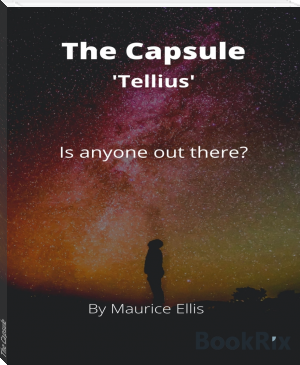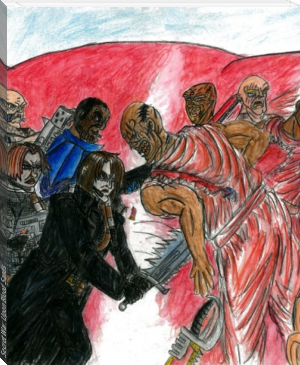The Capsule by Maurice Ellis (i can read book club .txt) 📖

- Author: Maurice Ellis
Book online «The Capsule by Maurice Ellis (i can read book club .txt) 📖». Author Maurice Ellis

The Capsule
‘Tellius’
A Science fiction short story
By:
Maurice Ellis
‘Smashwords Edition
The Capsule. ‘Tellius’
Copyright © 2019 by Maurice Ellis
All rights reserved. No part of this book may be reproduced or transmitted in any form or by any means without written permission from the author.
ISBN 9780463561782
This book is a work of fiction and any similarity to persons, living or dead, is purely coincidental.
Approx.: 9300 words
Acknowledgements
I want to thank my brother David Ellis, B.Eng. (Hons) M.Sc. for his helpful advice and editing.
It was our long discussions on science and science fiction which led me to writing this story.
Contents
Chapter 1 -The Discovery.
Chapter 2 – Investigation.
Chapter 3 – Inside the capsule.
Chapter 4 – Deciphering.
Chapter 5 – The test flight.
Chapter 6 - The return.
Chapter 7 – Manned flight.
Chapter 8 – Lost in space.
Chapter 9 – The Onawans
Chapter 10– Homeward bound
Chapter 1 - Discovery
During the Blitz on London from 1940 to 1941, the German Luftwaffe dropped over 30,000 tons of bombs and more than 40,000 people were killed. After which London enjoyed a period of relative calm. Then, without warning, on the evening of January 22nd, 1944, at around 8.45 pm, they came again. More than four hundred German bombers dropped a massive number of incendiary bombs and high explosives. The Germans called it 'Operation Steinbock'.
With such a huge number of explosives being dropped, and with people running for cover, no one noticed the incongruous object which landed in the River Thames about three hundred metres downstream from Tower Bridge. It didn't explode but sliced through the water and sank into the river bed to about tree metres below the silt and mud. It lay undisturbed for the next ninety-five years.
* * * * *
On July 12th.. 2039, a small motor launch with a married couple on board caught fire and exploded approximately three hundred metres downstream from Tower Bridge. The river police were soon on the scene and rescued a middle-aged woman who had been thrown clear. She suffered serious but not life-threatening burns and was quickly taken to the nearest hospital. There was no sign of her husband. After fifteen minutes of searching the police diver found the body of the woman's husband. He was lying at the bottom of the river, straddled across what looked like a large rock. After the body was raised to the surface and placed in the police launch the diver said he was going back down to have another look at that rock.
The rock was not completely exposed. The diver worked his way around it. As far as he could estimate the part that was showing was about one metre high and three metres long. It was not possible to say how much of it was buried in the river bed. It had an oval shape and, when he touched it, felt that there was slight warmth to it. This didn't make sense as the temperature of the river should have kept it cold. When he returned to the launch and told the other officers what he had discovered, they decided that the rock posed a threat to shipping and would report their findings to the appropriate authorities.
* * * * *
A few days later a large barge with a crane on board was brought in and manoeuvred into position above and slightly to one side of the rock's position. Two divers went down and secured it to a harness with which it was easily lifted up and onto the deck of the barge. It could now be seen that it was about three metres long and two metres high, in a teardrop shape, and deep blue in colour. According to the crane operator, its size belied its weight. He estimated that it should have weighed at least seven tons but was nowhere near that. The barge moved downstream and finished up at St. Katherine Docks. It was unloaded onto the back of an eighteen-wheeler flatbed truck. The truck driver had been given instructions to take it to the headquarters of the British Geological Society just outside Nottingham.
Chapter 2 - Investigation
Two of the society's geologists studied the rock. They both quickly came to the same conclusion: Because it was much lighter than it should have been, warm to the touch, and not a colour associated with normal rocks, this was a manufactured artefact. But why, by whom and for what purpose were at this point questions without answers. They tapped it gently several times with a small spanner and realised that it was not solid because of its hollow, metallic sound. For all they knew, it could be an explosive device and this was something out of their field of expertise, so they decided to get in touch with the Ministry of Defence in Whitehall. They were told to keep it under wraps, literally, until an army bomb disposal unit arrived. Within an hour the bomb disposal unit turned up. The rock was loaded onto a truck and taken to a nearby army base.
The men of the bomb disposal unit inspected the rock carefully and came to a quick decision. It was not a rock. It was man-made, apparently hollow, but could easily house an explosive of some kind. They found no point of entry, and it appeared to be seamless. They could blow it up to render it safe, but decided against this since they had no idea of how much, if any, explosive it contained. After some deliberation, it was decided to call in the radiographer and try to see what was inside. Radiography can be used to inspect most materials and is especially good at finding internal features, including hidden objects. It can also measure the thickness of materials.
It didn't take the radiographer long to make a discovery. It was nothing like a rock, it was a capsule. Not one oval shaped object but two. The outer shell had no entry point but the inner one did. It appeared that the outer shell was moulded around the inner one for protection and perhaps to stop anyone from gaining access. He also discovered that there were several compartments built along each side of the inner shell. Each compartment was giving off enough heat to keep the whole object warm to the touch.
Should they try to gain access or was that too risky? Was there explosive material in the hidden chambers? The more the group discussed it the more convinced they became that to open it was worth the risk. After all, nothing like this had ever been seen before. The most puzzling thing was that the material of the object was not anything they had come across before. It was more than likely a composite alloy of two or more metals. But the fact still remained, what was its purpose?
Based on the radiographer’s findings they marked out an area around corresponding to the inner entry point. The size of the cut was large enough for a man to get through and far enough away from the sides of the inner opening so as not to damage it with the heat from the oxyacetylene torch.
It took them the best part of an hour to cut away the first section. The outer shell was only loosely fixed to the inner one and was quite easily prised away, leaving the inner shell entry panel exposed. There were seven unusual bolts holding the entry panel in place. They were not of a type that any of the crew had seen before. They used a diamond-tipped drill on the bolts and within forty minutes had drilled through them all. The crew were beginning to tire by then, but were able to lever off the entry panel. As it fell to the ground they could see inside the capsule with the aid of a torch.
The officer in charge of the bomb disposal unit made the other men stand well back from the capsule. He was concerned that it might contain something radioactive. Another thing which worried him was the heat coming out through the opening. He donned a hazmat suit for protection against the possibility of radiation and approached the capsule holding a Geiger counter.
Chapter 3 – Inside the capsule.
The Geiger counter showed only a faint trace of radiation. Not enough to cause any long-term damage. The officer put the torch through the opening and followed through with his head. He could see a total of nine separate compartments. Four on both sides, and a slighter, larger one to the rear. It was warm inside the capsule, about twenty-nine degrees Celsius, but was starting to cool down now that the hatch was open, and the warm air could escape. He reached for the larger box and found it unmovable. It was attached quite rigidly to the hull. The most practical way was to put a small man inside to see if the box could be removed. He called the corporal forward and asked him to get inside the capsule and see if he could open any of the compartments.
Once inside, the corporal shone his torch towards the largest compartment at the rear of the capsule. As the beam rose above the box he noticed something he was not expecting. There was writing on the wall. Not English or any other languages he was familiar with. It was written in a series of totally unrecognisable symbols. Not unlike ancient Egyptian but with no pictures of animals, just symbols. He asked for a camera and the officer handed him one. The corporal took several pictures and climbed out of the capsule. He showed the digital photos to the rest of the crew. Nobody had any idea what the symbols meant. The officer decided to inform his commanding officer of their findings. After studying the photos, the C.O. suggested calling the archaeology department at Cambridge University. They advised him to keep a close watch on the capsule and wait for Professor Peter Maynard, a renowned archaeologist and linguist, to visit them the next day.
* * * * *
Professor Colin Maynard arrived at the army base at ten-thirty the next morning and was taken to where the capsule was being kept under guard. Having looked inside he asked for some tools and, not being a big man, he was slim and only five feet six inches tall, and managed to get inside the capsule. He studied the script and noticed a line pointing down from the bottom of the writing to the sealed compartment underneath. To him this was a message to open it, which he immediately set about doing. It took him about twenty minutes to open the compartment. Once open, he looked inside. He saw several pieces of what looked like parchment. He removed them carefully, made his way out of the capsule and laid out the items on a nearby table after studying them for about two minutes he turned to the watching crew. “My God, you won't bloody well believe this!” he exclaimed loudly. Not a deep voice but still a commanding one. He had moved from Glasgow in his early twenties, to Cambridge, and his Scottish accent had diminished somewhat but was still noticeable. Aged thirty-eight he had never married.
Professor Maynard explained what he had just found. The parchments showed drawings of human-like figures, another showed pictures of strange looking buildings and the third parchment was clearly a map. It appeared to be an astronomical map of the Milky Way. And one of the planets on that map was circled





Comments (0)